The 2012 MacBook Air (11 & 13-inch) Review
by Anand Lal Shimpi on July 16, 2012 12:53 PM EST- Posted in
- Apple
- Mac
- MacBook Air
- Laptops
- Notebooks
The More Complicated (yet predictable) SSD Lottery
Apple continues to use a custom form factor and interface for the SSDs in the MacBook Air. This generation Apple opted for a new connector, so you can't swap drives between 2011 and 2012 models. I'd always heard reports of issues with the old connector from a manufacturing standpoint, so the change makes sense. The new SSD connector looks to be identical to the one used by the Retina Display equipped MacBook Pro, although rest of the SSD PCB is different.

The Toshiba Branded SandForce SF-2200 controller in the 2012 MacBook Air - iFixit
As always there are two SSD controller vendors populating the drives in the new MacBook Air: Toshiba and Samsung. The Samsung drives use the same PM830 controller found in the 2012 MacBook Pro as well as the MacBook Pro with Retina Display. The Toshiba drives use a rebranded SandForce SF-2200 controller. Both solutions support 6Gbps SATA and both are capable of reaching Apple's advertised 500MB/s sequential access claims.
While in the past we've recommended the Samsung over the Toshiba based drives, things are a bit more complicated this round because of the controller vendor Toshiba decided to partner with.

The write/recycle path in NAND flash based SSD
Samsung's PM830 works just like any other SSD controller. To the OS it presents itself as storage with logical block addresses starting from 0 all the way up to the full capacity of the drive. Reads and writes come in at specific addresses, and the controller maps those addresses to blocks and pages in its array of NAND flash. Every write that comes in results in data written to NAND. Those of you who have read our big SSD articles in the past know that NAND is written to at the page level (these days pages are 8KB in size), but can only be erased at the block level (typically 512 pages, or 4MB). This write/erase mismatch combined with the fact that each block as a finite number of program/erase cycles it can endure is what makes building a good SSD controller so difficult. In the best case scenario, the PM830 will maintain a 1:1 ratio of what the OS tells it to write to NAND and what it actually ends up writing. In the event that the controller needs to erase and re-write a block to optimally place data, it will actually end up writing more to NAND than the OS requested of it. This is referred to as write amplification, and is responsible for the performance degradation over time that you may have heard of when it comes to SSDs.
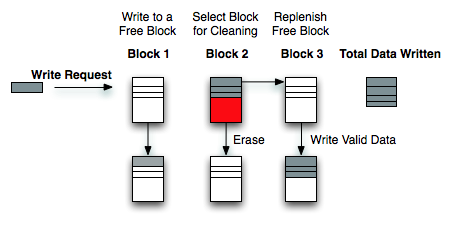
Write Amplification
For most client workloads, with sufficient free space on your drive, Samsung's PM830 can keep write amplification reasonably low. If you fill the drive and/or throw a fragmented enough workload at it, the PM830 doesn't actually behave all that gracefully. Very few controllers do, but the PM830 isn't one of the best in this regard. My only advice is to try and keep around 20% of your drive free at all times. You can get by with less if you are mostly reading from your drive or if most of your writes are just big sequential blocks (e.g. copying big movies around). I explain the relationship between free space and write amplification here.

Write Amplification vs. Spare Area, courtesy of IBM Zurich Research Laboratory
The Toshiba controller works a bit different. As I already mentioned, Toshiba's controller is actually a rebranded SandForce controller. SandForce's claim to fame is the ability to commit less data to NAND than your OS writes to the drive. The controller achieves this by using a hardware accelerated compression/data de-duplication engine that sees everything in the IO stream.
The drive still presents itself as traditional storage with an array of logical block addresses. The controller still keeps track of mapping LBAs to NAND pages and blocks. However, because of the compression/dedupe engine, not all data that's written to the controller is actually written to NAND. Anything that's compressible, is compressed before being written. It's decompressed on the fly when it's read back. All of the data is still tracked, the drive still is and appears to be the capacity that is advertised (you don't get any extra space), you just get extra performance. After all, writing nothing is always faster than writing something.
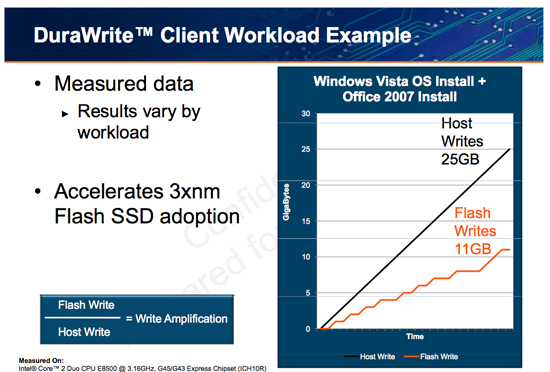
Writing less data to NAND can improve performance over time by keeping write amplification low. There are also impacts on NAND endurance, but as I've shown in the past, endurance isn't a concern for client drives and usage models. Writing less also results in a slight reduction in component count: there's no external DRAM found on SandForce based drives. The PM830 SSD features a 256MB DDR2 device on-board, while the Toshiba based drive has nothing - just NAND and the controller. This doesn't end up making the Toshiba drive substantially cheaper as SandForce instead charges a premium for its controller. In the case of the PM830, both user data and LBA-to-NAND mapping tables are cached in DRAM. In the case of the Toshiba drive, a smaller on-chip cache is used since there's typically less data being written to the NAND itself.
SandForce's approach is also unique in that performance varies depending on the composition of the data written to the drive.
PC users should be well familiar with SandForce's limitations, but this is the first time that Apple has officially supported the controller under OS X. As such I thought I'd highlight some of the limitations so everyone knows exactly what they're getting into.
Any data that's random in composition, or already heavily compressed, isn't further reduced by Toshiba's SandForce controller. As SandForce's architecture is designed around the assumption that most of what we interact with is easily compressible, when a SF controller encounters data that can't be compressed it performs a lot slower.
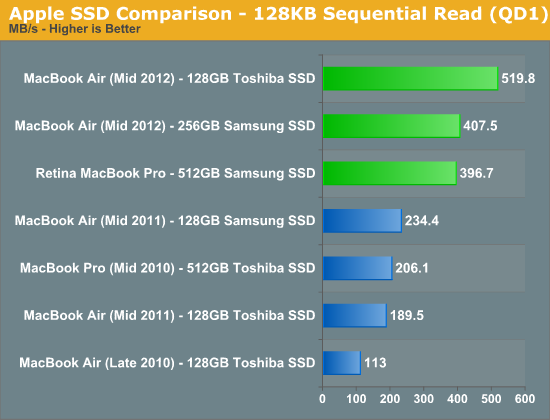
Special thanks to AnandTech reader KPOM for providing the 256GB Samsung results
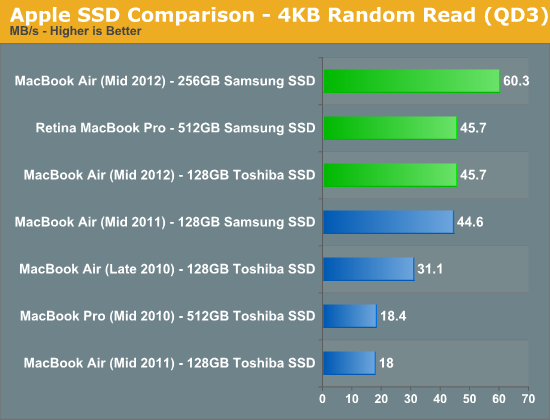
The performance impact is pretty much limited to writing. We typically use Iometer to measure IO performance as it's an incredibly powerful tool. You can define transfer size, transfer locality (from purely sequential all the way to purely random) and even limit your tests to specific portions of the drive, among other features. Later versions of Iometer introduced the ability to customize the composition of each IO transfer. For simplicity, whenever Iometer goes to write anything to disk it's a series of repeating bytes (all 0s, all 1s, etc...). Prior to SandForce based SSDs this didn't really matter. SandForce's engine will reduce these IOs to their simplest form. A series of repeating bytes can easily be represented in a smaller form (one byte and a record of how many times it repeats). Left at its default settings, SandForce drives look amazing in Iometer - even faster than the PM830 based Samsung drive that Apple uses. Even more impressive, since very little data is actually being written to the drive, you can run default Iometer workloads for hours (if not days) on end without any degradation in performance. Doing so only tells us part of the story. While frequently used OS and application files are easily compressed, most files aren't.
Thankfully, later versions of Iometer include the ability to use random data in each transfer. There's still room for some further compression or deduplication, but it's significantly reduced. In the write speed charts below you'll see two bars for the Toshiba based SSD, the one marked incompressible uses Iometer's random data setting, the other one uses the default write pattern.
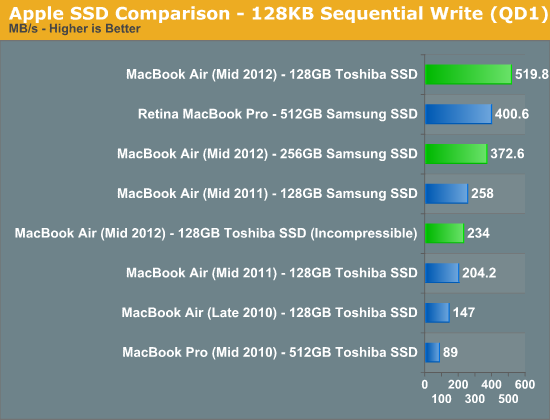
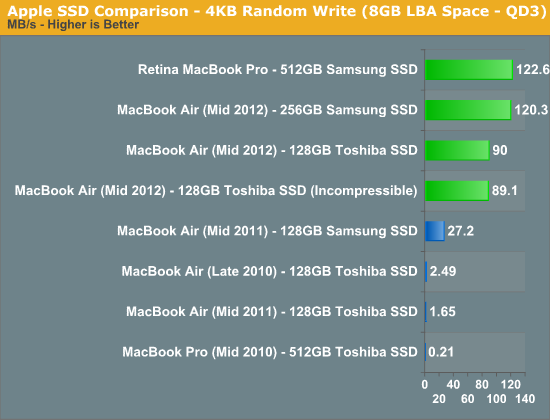
When fed easily compressible data, the Toshiba/SandForce SSD performs insanely well. Even at low queue depths it's able to hit Apple's advertised "up-to" performance spec of 500MB/s. Random write performance isn't actually as good as Samsung's, but it's more likely to maintain these performance levels over time.
Therein lies the primary motivator behind SandForce's approach to flash controller architecture. Large sequential transfers are more likely to be heavily compressed (e.g. movies, music, photos), while the small, pseudo-random accesses are more likely easily compressible. The former is rather easy for a SSD controller to write at high speeds. Break up the large transfer, stripe it across all available NAND die, write as quickly as possible. The mapping from logical block addresses to pages in NAND flash is also incredibly simple. Fewer entries are needed in mapping tables, making the read and write of these large files incredibly easy to track/manage. It's the small, pseudo-random operations that cause problems. The controller has to combine a bunch of unrelated IOs in order to get good performance, which unfortunately leaves the array of flash in a highly fragmented state - bringing performance down for future IO operations. If SandForce's compression can reduce the number of these small IOs (which it manages to do very well in practice), then the burden really shifts to dealing with large sequential transfers - something even the worst controllers can do well.
It's really a very clever technology, one that has been unfortunately marred by a bunch of really bad firmware problems (mostly limited to PCs it seems).
The downside in practice is the performance when faced with these incompressible workloads. Our 4KB random write test doesn't actually drop in performance, but if we ran it for long enough you'd see a significant decrease in performance. The sequential write test however shows an immediate reduction of more than half. If you've been wondering why your Toshiba SSD benchmarks slower than someone else's Samsung, check to see what sort of data the benchmark tool is writing to the drive. The good news is that even in this state the Toshiba drive is faster than the previous generation Apple SSDs, the bad news is the new Samsung based drive is significantly quicker.
What about in the real world? I popped two SSDs into a Promise Pegasus R6, created a RAID-0 array, and threw a 1080p transcode of the Bad Boys Blu-ray disc on the drive. I then timed how long it took to copy the movie to the Toshiba and Samsung drives over Thunderbolt:
| Real World SSD Performance with Incompressible Data | ||||
| Copy 13870MB H.264 Movie | 128GB Toshiba SSD | 512GB Samsung SSD | ||
| Transfer Time | 59.97 s | 31.59 s | ||
| Average Transfer Rate | 231.3 MB/s | 439.1 MB/s | ||
The results almost perfectly mirrored what Iometer's incompressible tests showed us (which is why I use those tests so often, they do a good job of modeling the real world). The Samsung based Apple SSD is able to complete the file copy in about half the time of the Toshiba drive. Pretty much any video you'd have on your machine will be heavily compressed, and as a result will deliver the worst case performance on the Toshiba drive.
Keep in mind that to really show this difference I had to have a very, very fast source for the transfer. Unless you've got a 6Gbps SSD over USB 3.0 or Thunderbolt, or a bunch of hard drives you're copying from, you won't see this gap. The difference is also less pronounced if you're copying from and to the same drive. Whether or not this matters to you really depends on how often you move these large compressed files around. If you do a lot of video and photo work with your Mac, it's something to pay attention to.
There's another category of users who will want to be aware of what you're getting into with the Toshiba based drive: anyone who uses FileVault or other full disk encryption software.
Remember, SandForce's technology only works on files that are easily compressed. Good encryption should make every location on your drive look like a random mess, which wreaks havoc on SandForce's technology. With FileVault enabled, all transfers look incompressible - even those small file writes that I mentioned are usually quite compressible earlier.
After enabling FileVault I ran our Iometer write tests on the drives again, performance is understandably impacted:
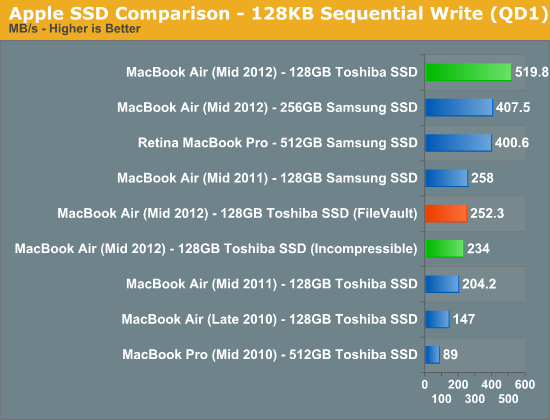
Also look at what happens to our 4KB random write test if we repeat it a few times back to back:
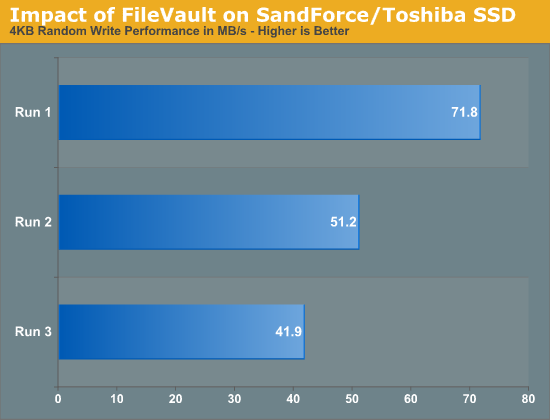
That trend will continue until the drive's random write performance is really bad. Sequential write passes will restore performance up to ~250MB/s, but it takes several passes to get it there:
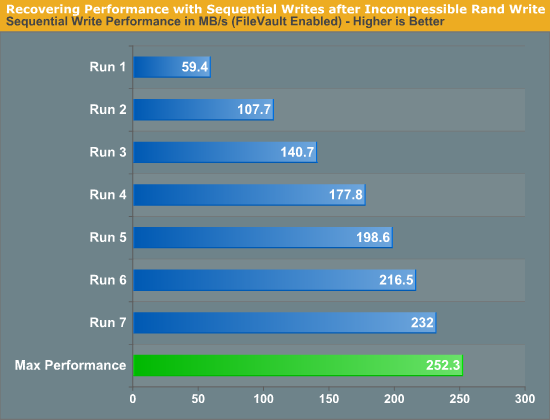
If you're going to be using FileVault, stay away from the Toshiba drive.
This brings us to the next problem: how do you tell what drive you have?
As of now Apple has two suppliers for the SSD controllers in all of its 2012 Macs: Toshiba and Samsung. If you run System Information (click the Apple icon in the upper left > About this Mac > System Report) and select Serial ATA you'll see the model of your SSD. Drives that use Toshiba's 6Gbps controller are labeled Apple SSD TSxxxE (where xxx is your capacity, e.g. TS128E for a 128GB drive), while 6Gbps Samsung drives are labeled Apple SSD SMxxxE. Unfortunately this requires you to already purchase and open up your system. It's a good thing that Apple stores are good about accepting returns.
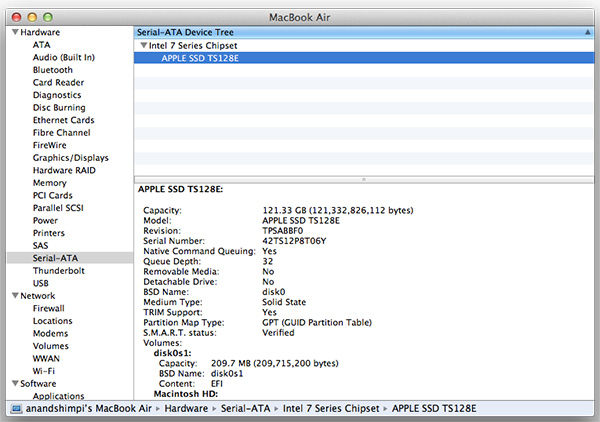
There's another option that seems to work, for now at least. It seems as if all 256GB and 512GB Apple SSDs currently use Samsung controllers, while Toshiba is limited to the 64GB and 128GB capacities. There's no telling if this trend will hold indefinitely (even now it's not a guarantee) but if you want a better chance of ending up with a Samsung based drive, seek out a 256GB or larger capacity. Note that this also means that the rMBP exclusively uses Samsung controllers, at least for now.
I can't really blame Toshiba for this as even Intel has resorted to licensing SandForce's controllers for its highest performing drives. I will say that Apple doesn't seem to be fond of inconsistent user experiences across its lineup. I wouldn't be surprised if Apple sought out a third SSD vendor at some point.










190 Comments
View All Comments
TechKnow12 - Saturday, September 22, 2012 - link
I too was planning on buying an SD card to use as extra storage. I just bought a 128Gb MBA rather than 256Gb as it was $300 cheaper. Firstly, I wasn't aware of the deep sleep issue with the SD card however I discovered the same issue with leaving a USB drive connected. I'll investigate your two solutions below. Thanks for posting that info!Lastly, I did some research on SD card performance/speed. Something to keep in mind for anyone who is also planning to do this, the cheaper ones only have a speed of around 30MB/s and the faster, more expensive ones with a speed of 95MB/s. When you compare the cost of the faster cards to the option of buying a MBA with the 256Gb's, the best option would have been to buy the 256Gb MBA.
The following is a short speed comparison of SD cards vs. USB vs. MBA SSD:
SD 30MB/s = 240mbps
SD 45MB/s = 360mbps
SD 65MB/s = 520mbps
SD 95MB/s = 760mbps
USB 2.0 (60MB/s) = 480mbps
USB 3.0 (625MB/s) = 5000mbps
MacBook Air 2012 SSD: writes at 364MB/sec, reads at 461MB/sec
In speed order:
SD 30MB/s = 240mbps
SD 45MB/s = 360mbps
* MacBook Air 2012 SSD: writes at 364MB/sec, reads at 461MB/sec
USB 2.0 (60MB/s) = 480mbps
SD 60MB/s = 480mbps
SD 95MB/s = 760mbps
USB 3.0 (625MB/s) = 5000mbps
So for best performance (read/write speeds) I would go with the 60MB/s SD card however it is expensive. Around $300 for 128Gb. Thus it probably would have been better to buy the MBA 256Gb version. Or you could go for a Sandisk 128Gb 45MB/s card for $170. Slightly slower then MBA's SSD but should be good enough for music and video files (I think). Would be good to find out from anyone using an SD card for storage what they think.
:)
TechKnow12 - Saturday, September 22, 2012 - link
Sorry, made an error with the SD 65MB/s in the first list. Should have read:SD 60MB/s = 480mbps not SD 65MB/s = 520mbps
:)
phillyry - Thursday, March 28, 2013 - link
Dude. The ssd speeds and sizes are both in MB/s and GB, not Mb/s and Gb. So, the internal storage (SSD) is running at 360-460MB/s and your SD cards are capped out at 95MB/s.400MB/s is clearly better than 95MB/s. No need for conversions, as they're both already in MB/s.
The Sandisk 45 MB/s SD card is an ORDER OF MAGNITUDE SLOWER (10x) than the SSD in the MBA.
You would only buy an SD for either transferring files or getting a little extra (non-critical) storage capacity.
Not only will the drive be slower than a typical mechanical hard drive - only the 95MB/s ones will pass a basic 80MB/s HDD - it will be around 1/10 to 1/5 the speed of the SSDs in the 2012 MBA.
cookiezulu - Wednesday, August 1, 2012 - link
In the meantime I have found (via another user - thanks Ken Ng) that there are too apps on Mac App store for this purpose (unmounting external devices when laptop goes to sleep and remounting them automatically when laptop is taken out of sleep):- AutoEJECT (by DragonBTV developer)
- Jetisson (by StClair Software)
TechKnow12 - Saturday, September 22, 2012 - link
Well, I got really fed up with the performance of my WIndows 7 based netbook and the lack of good and abundant support from the netbook manufacturers website. Apple has that many forums that you can always get some sort of assistance somewhere. As for Windows 7 it is less intuitive than Windows XP which for me personally resulted in a less than desirable user experience. My netbook had a multitouch touch pad but not as advanced as MBA.I was rather impressed with the performance and quality of the MBA that I decided to take the plunge and get one. Now this is my first ever experience with Mac and OSX. It took me a little bit of acclimatising however OSX is so much easier to use, more intuitive. The experience so far has been awesome. There are lots of hidden tricks with the touch pad which are awesome too.
There are too many PROs to list. As for CONs there are just a couple which I've encountered. One that is easily fixable is the auto adjusting screen brightness. On a cloudy day where ambient brightness can change constantly as clouds move by, the brightness fluctuates constantly to match. Not very pleasant for the eyes. Simple fix is to turn off this function. The other is web page loading where Safari just hangs and does nothing until you re click on the link or cancel the page load then hit refresh. Doesnt seem to be a problem with Firefox.
Battery life is good and as stated. Cut a couple of hours off that if you're streaming Youtube clips or playing music. But again, as it goes with battery life, it is all subjective to how you use the MBA.
So will I ever go back to Windows? No.
I've been running Windows 8 RC on a spare PC and it is less intuitive than Win 7. It's actually quite horrible. Not something I would want to use permanently.
I think more people are going to be making the switch to Mac in future.
TechKnow12 - Monday, October 1, 2012 - link
Heh hehhh! I'm going back on my word or rather on my statement above regarding Windows. :pSince actually having tried out Bootcamp and installing Windows 7, I can now run Win 7 natively and run Win only programs. Win 7 runs really well on MBA. Battery life is about the same. Voice control works well with the inbuilt microphone.
I love how Bootcamp has given me dual boot functionality as I originally thought Bootcamp was akin to VMWare.
It's virtually like having two ultrabooks in one. One Mac and one Windows.
Unfortunately Safari swipe gestures (back & fwd) aren't supported under Windows.
And OSX doesn't have voice control to control everything like Win 7 does. But I guess that will come soon as Siri develops and hopefully makes it to OSX. :)
ald - Friday, November 16, 2012 - link
I was wondering about the calibration profile provided for the LG display of Macbook air, to me it seems like it makes greys a little brown and whites a little yellow, and when you look at the display from side it has a weird green tint. Does anyone else have the same problem. I have downloaded this profile from http://osxdaily.com/2011/10/30/how-to-check-for-an... which seems to do a much better job.tdtran1025 - Tuesday, November 27, 2012 - link
The time is right for Apple to deploy their brew of ARM-based SoC in Airs, basing on the performance of the latest iPad. It would make sense for Apple to indulge this form factor to increase their gross margin, and for those who despise touch typing. I am sure Apple will find ways to increase the performance of the current ARM processors to match that of low end Intel C2D within 18 months. All that power saving may push battery performance to beyond 5 hours in the Airs, something we can all go for.phillyry - Thursday, March 28, 2013 - link
Are you crazy?Arm is nowhere near where it needs to be to run OS X.
DPsocial - Wednesday, January 9, 2013 - link
This computer is absolutely perfect for college http://bit.ly/MacBook_Air_DPS My roommate used this computer through college, very light and perfect for going to class. Highly recommended.